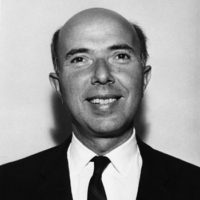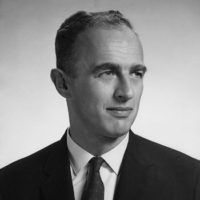
Renato Dulbecco
Salk Institute of Biological Studies

Harry Rubin
University of California at Berkeley
For fundamental contributions to our knowledge of the relationship between cancer and cancer-producing DNA and RNA viruses.
Dr. Dulbecco's early work on bacterial viruses led to the development of methods for investigating the process of viral infection of normal cells in culture. Application of these methods to the study of the transformation of normal cells into cancer cells by polyoma virus, a DNA-containing virus, resulted in the important finding that cancerous transformation can occur in the absence of virus multiplication. This finding suggests the possibility that integration of the viral DNA—the genetic material of the virus—into the DNA of the recipient cells may be the factor that triggers the transformation of normal cells into cancer cells.
Following the initial transformation, which is the result of a release from normal regulation of cell multiplication, successive generations of cells become increasingly malignant. Dr. Dulbecco correlated this increase in malignancies with irregularities in the process of multiplication of the cells' chromosomes. This irregularity may lead to hereditary alteration of the cells and the continuous selection of cells of higher and higher malignancy.
Dr. Dulbecco showed further that the DNA of the polyoma virus exists in two forms, a linear and a ring form. Both forms give rise to new virus and to cancer when they enter receptive cells, but the ring form is more active. Dr. Dulbecco's outstanding work, together with Dr. Rubin's studies on tumor-producing RNA viruses, promises to contribute decisively to our eventual understanding of the nature of cancer.
Dr. Rubin's work has given new insight into the mode in which cancer-producing RNA viruses bring about the transformation of normal cells into cancer cells while disclosing, at the same time, other facts of broad biological significance. He found that avian leukosis—a form of leukemia produced by certain strains of an RNA-containing virus—is transmitted to the progeny through the egg, but not through the sperm. This indicates that the genetic material of the RNA-containing tumor viruses does not become associated with the chromosomes of recipient cells.
While working in Dr. Dulbecco's laboratory, Dr. Rubin developed a method for the study of the tumoral transformation of cultured chick cells by the Rous sarcoma virus, an RNA virus. When applying this method later to this problem, he found that the Rous virus actually consists of two viruses. These two viruses were separated, and Rous virus alone caused the malignant transformation, but the transformed cells contained no infectious virus even after many passages. The other virus, known to cause chicken leukosis, did not cause malignant transformation although it multiplied in all cells. When leukosis virus was added to the cells transformed into cancer cells from the Rous virus alone, the cells produced not only the leukosis virus but also Rous virus. Obviously the Rous virus was defective in that only the RNA was being replicated in these cells. The virus could not mature without the help of a second virus, called a helper virus, which provides its protein coat to the Rous virus.
The work of Drs. Rubin and Dulbecco proves that cells can carry for many generations a foreign nucleic acid, whether RNA or DNA, that is responsible for the malignant properties of these cells.
These brilliant scientists have translated their laboratory precision of today into definitive guidelines for the cancer research of tomorrow. Their contributions have sped the day when research will eradicate this most dreaded of all diseases.
